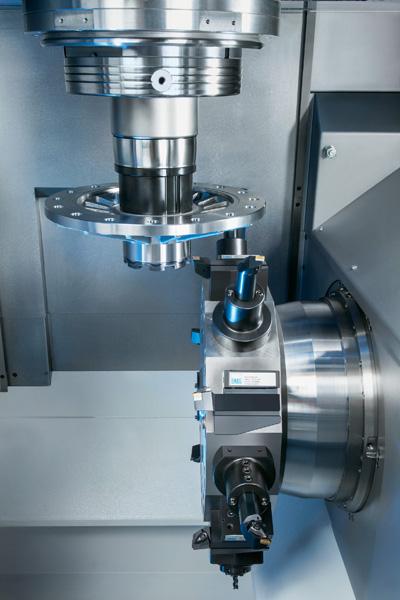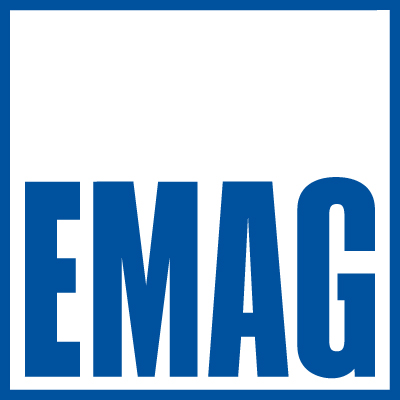
The market for commercial vehicles is experiencing a vibrant development. Emerging economies have a growing need for new technologies in the production of semitrucks and agricultural machines, enabling them to achieve the desired growth in the construction industry and agriculture. New manufacturers from China, for instance, intensify the price war, putting today's production planners under considerable pressure. The future of commercial vehicle production lies in being faster, more energy efficient and increasingly flexible. EMAG, with its VL 8 vertical pick-up turning machine for workpieces up to 16 inches in diameter, offers a solution for the production of commercial vehicle components.
Large vehicles equal large constituent components, to describe commercial vehicle production simply. However, the manufacturing of especially large and heavy components (for instance for the powertrain of semi-trucks, excavators or buses) poses a unique set of challenges: how can a large clamped component be machined economically and, at the same time, with the highest precision? How does the demanding task of handling such components not result in an unmanageably long production process? The VL 8 vertical pick-up turning machine, the latest from EMAG's machine experts, provides the solutions to these challenges.
All the advantages of the VL series have been transferred directly to a machine specially designed for the handling of large components, where a number of different turning and milling operations are carried out within the framework of a single closed-loop production process. Integrated automation ensures quicker production times, and the vertical layout a high degree of process integrity where chip flow causes no problem. Subcontractors and component suppliers benefit from short idle times, high component quality and sinking unit costs. The VL 8 is rapidly becoming a true "cost-killer" in the production of commercial vehicles, according to the company.
The basic design of the VL 8 closely follows that of the successful VL series. Sturdy machine construction, dynamic axes and simple operation are the main characteristics of these machines. They are also based on a completely new machine concept that allows for a variety of production technologies for soft and hard machining to be combined, achieving a very attractive price-performance ratio. The following major components ensure a highly efficient production process on the VL:
• A machine base of the polymer concrete MINERALIT, guaranteeing vibration resistant processes, providing for an excellent tool life and outstanding machining quality.
• The front of the machine base features a compound slide carrying the vertical main spindle that dynamically traverses the Z and X axes. With a chuck diameter of 20 inches, the pick-up spindle accepts workpieces up to 16 inches diameter.
• The machining process uses a main spindle with 60 kW rating, a torque of up to 572 ft-lb and speeds of up to 2,850 rpm.
• The turret accommodates 12 turning or, optionally, 12 driven drilling and milling tools. The workpieces are loaded into the carrier prisms of a conveyor belt and positioned via NC axis.
The pick-up spindle collects the workpieces from the lateral conveyor belt and takes them to the machining area. Short travel distance ensures minimal chip-to-chip times. A highly flexible machining process allows for the use of a large variety of tools. It is also possible to link up two machines and a component turnover station to create a flexible production cell to completely machine the first and second sides of a workpiece in one cycle, for instance. Additionally, the integration of a Y-axis in the turret allows for the "off-center" machining of more complex geometries.
Other features have been developed to ensure precision during the machining process. The spindle, for example, where short distances between the bearings, the use of high-precision separable bearings in a tandem-O-tandem arrangement and support bearings with length compensation at the spindle end provide for a particularly sturdy construction – an important basic condition for micrometer-precision turning processes. Precision is maintained through the integration of an inspection process into the cycle sequence. The required probe is installed outside the machining area and checks the workpiece while it is still clamped. Any corrective data is sent to the CNC control and the process is adjusted accordingly. This guarantees consistently high precision even during automatic operation. All service units are easily accessible and with an operator to turret distance of just 400mm tool changes quick and easy.
The machine builders at EMAG have always put their trust in tested components considered standard in manufacturing circles. This ensures that the VL 8 can be available within a few weeks and at a very attractive price-performance ratio. In short, the VL 8 combines all the factors that make it possible to reduce component costs in commercial vehicle production: low investment costs, flexible and fast production processes and a sturdy machine construction.
Contact Details
Related Glossary Terms
- chuck
chuck
Workholding device that affixes to a mill, lathe or drill-press spindle. It holds a tool or workpiece by one end, allowing it to be rotated. May also be fitted to the machine table to hold a workpiece. Two or more adjustable jaws actually hold the tool or part. May be actuated manually, pneumatically, hydraulically or electrically. See collet.
- computer numerical control ( CNC)
computer numerical control ( CNC)
Microprocessor-based controller dedicated to a machine tool that permits the creation or modification of parts. Programmed numerical control activates the machine’s servos and spindle drives and controls the various machining operations. See DNC, direct numerical control; NC, numerical control.
- gang cutting ( milling)
gang cutting ( milling)
Machining with several cutters mounted on a single arbor, generally for simultaneous cutting.
- milling
milling
Machining operation in which metal or other material is removed by applying power to a rotating cutter. In vertical milling, the cutting tool is mounted vertically on the spindle. In horizontal milling, the cutting tool is mounted horizontally, either directly on the spindle or on an arbor. Horizontal milling is further broken down into conventional milling, where the cutter rotates opposite the direction of feed, or “up” into the workpiece; and climb milling, where the cutter rotates in the direction of feed, or “down” into the workpiece. Milling operations include plane or surface milling, endmilling, facemilling, angle milling, form milling and profiling.
- numerical control ( NC)
numerical control ( NC)
Any controlled equipment that allows an operator to program its movement by entering a series of coded numbers and symbols. See CNC, computer numerical control; DNC, direct numerical control.
- turning
turning
Workpiece is held in a chuck, mounted on a face plate or secured between centers and rotated while a cutting tool, normally a single-point tool, is fed into it along its periphery or across its end or face. Takes the form of straight turning (cutting along the periphery of the workpiece); taper turning (creating a taper); step turning (turning different-size diameters on the same work); chamfering (beveling an edge or shoulder); facing (cutting on an end); turning threads (usually external but can be internal); roughing (high-volume metal removal); and finishing (final light cuts). Performed on lathes, turning centers, chucking machines, automatic screw machines and similar machines.
- turning machine
turning machine
Any machine that rotates a workpiece while feeding a cutting tool into it. See lathe.

